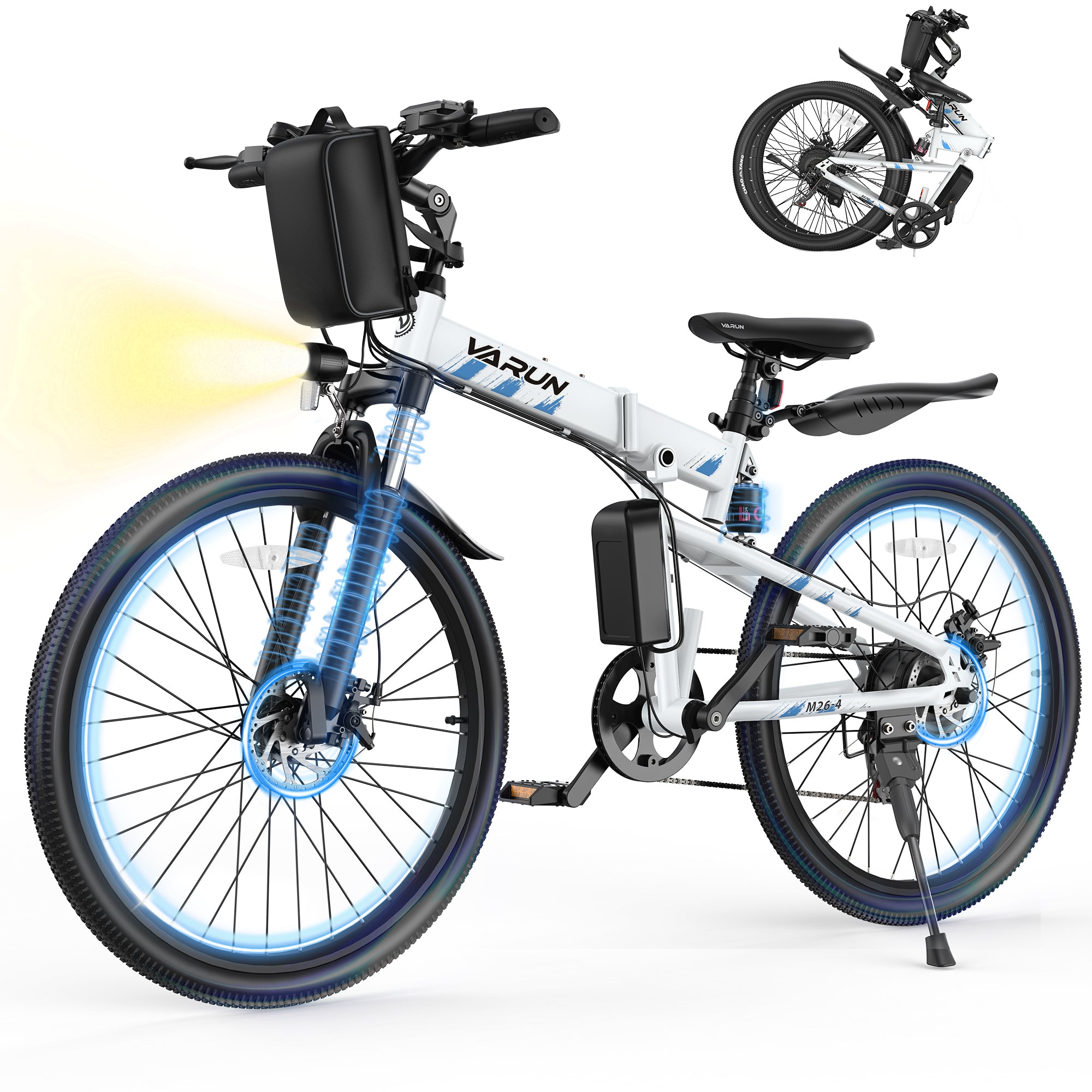Fat tire e-bikes are unbeatable on sand, snow, mud, and loose gravel—but their bigger contact patch and higher system weight mean maintenance matters even more. Use this pro checklist to keep your Fat tire e-bike fast, quiet, and reliable.
1) Fat Tires & Wheels: pressure, sealing, spoke health
Dial pressure to terrain.
-
Hardpack/gravel: ~12–18 PSI (heavier riders toward the high end).
-
Sand/snow: ~6–10 PSI for float; avoid rim strikes.
-
Slick roots/rocks: ~10–14 PSI, then fine-tune.
Consider tubeless (if the rim/tire combo allows) to reduce pinch flats and run lower pressures safely. Refresh sealant every 3–6 months.
Check true & spoke tension monthly. Fat rims see larger side loads; fix looseness early to prevent cracked nipples or eyelets.
-
ENGWE X26 uses 26×4.0″ tires—ideal for pressure tuning and tubeless setups for mixed terrain. It’s paired with a high-capacity 48V 29.2Ah battery option, so getting pressures right noticeably boosts range.
-
VARUN M26-2 PRO runs 26×4.0″ tires; periodic spoke checks keep that wide rubber tracking straight on rough ground.
2) Brakes: stop power without fade
Bed-in new pads & rotors with 10–15 firm decelerations from ~25 km/h to walking pace.
Go big on rotors for heavier e-bikes (200–220 mm front). Inspect pad thickness every 300–500 km or after gritty rides.
Keep rotors clean (isopropyl wipe) and avoid contamination.
-
ENGINE PRO 2.0 and X26 are higher-power Engwe builds; upgrading to quality pads and ensuring large rotor spec pays off on long descents.
-
VARUN X-PLORER (20×4″ fat tires) benefits from consistent brake service because small wheels + fat rubber put more torque into the system at a given speed.
3) Drivetrain: quiet, efficient, long-lasting
Choose lube by conditions.
-
Dry/dusty → dry or wax lube.
-
Wet/muddy → wet lube, then wipe chain after rides.
Clean cassette and jockey wheels monthly; re-lube after any hose-down.
Measure chain wear every 300–500 km (replace at 0.5–0.75% elongation) to protect cassette/chainring.
-
The compact, dual-battery-capable ENGWE M20 (20×4″) is popular for urban + off-road crossover; short chainstays make precise chain length and fresh lube especially important for crisp shifting under load.
4) Suspension, Headset & Contact Points
If your bike has suspension, wipe stanchions after every ride and perform a lower-leg service ~every 50 hours.
Re-grease headset bearings each season; fat-tire impacts transmit big forces through the front end.
Torque audit monthly (bar/stem, axle nuts/through-axles, saddle, racks). Use a torque wrench and paint-mark bolts so movement is obvious.
-
Riders using M26-2 PRO (26×4.0″) for trail duty should schedule headset checks with the same cadence as chain wear checks.
5) Battery Care: more Wh, more attention
Charge window for longevity: daily use around 20–85%, with a 100% balance charge every few weeks.
Let packs cool before charging after hard rides.
Store at ~60% in a cool, dry place if idle >2 weeks.
Inspect charge ports & connectors—keep caps closed when washing.
-
ENGWE X26 lists a 48V 29.2Ah option (≈1400 Wh). Smart charging habits noticeably extend lifespan on large packs.
-
ENGWE EP-2 Boost / L20 Boost (both 20×4″ fat tire formats) are commuter-friendly; port hygiene prevents intermittent charging issues over time.
6) Electronics & Controller Hygiene
Keep display/controller firmware updated if supported. Set PAS/throttle curves for smooth launches—gentler ramp-up protects drivetrains and improves traction.
Inspect wiring near the head tube for rub; secure with clips/zip-ties, leaving slack for full steering sweep.
-
Engwe Engine X and L20 3.0 PRO are good candidates for tailored PAS settings to match mixed commuting + trail use.
7) Cleaning: protect bearings, motor & seals
Skip pressure washers. Use low-pressure rinse, bike-specific cleaner, and soft brushes.
Degrease the drivetrain last to avoid solvent splash on rotors.
Dry thoroughly, then apply protectant film on cable rub points and rack interfaces.
-
VARUN X-PLORER (20×4″, utility-style frame) often runs racks/luggage—protect contact points with frame tape to avoid wear under vibration.
8) Seasonal & Terrain Prep
Winter: expect reduced range; keep batteries warm pre-ride. Consider softer compounds or studs.
Beach/salt: rinse immediately after exposure; re-lube and check fasteners.
Back-country: carry a tubeless plug kit, mini-pump/CO₂, spare brake pads, quick link, and multi-tool.
Quick Monthly Checklist
-
Tire pressure set for terrain; sidewalls OK; sealant topped up
-
Wheels true; spokes evenly tensioned
-
Pads >1 mm; rotors clean; lever feel firm
-
Chain wear ≤0.75%; cassette & pulleys clean
-
Headset/BB/play check; bolts torqued & paint-marked
-
Battery at planned SOC; ports clean and capped
-
Cables not rubbing; display & PAS modes working
- ENGWE X26 — 26×4.0″ tires + large 48V 29.2Ah option: perfect platform for pressure tuning, tubeless, and battery-care best practices.
-
ENGINE PRO 2.0 — higher-power Engwe with 20×4.0″ tires; benefits most from careful brake bed-in, big rotors, and regular chain wear checks.
-
ENGWE M20 — compact 20×4.0″ format; pay extra attention to chain length/lube and spoke tension due to short wheelbase loads.
-
VARUN M26-2 PRO — 26×4.0″ trail-ready fat bike; schedule headset and spoke checks alongside drivetrain service.
-
VARUN X-PLORER — 20×4.0″ utility build; protect luggage/rack contact points and keep rotor surfaces oil-free after beach rides.






Aktie:
How to Choose the Best Off-road Electric Bike?
The Professional Guide to City E-Bikes: Optimizing Urban Commuting